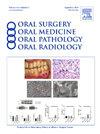RREB1::MRTFB融合阳性舌外间充质软骨粘液样肿瘤
IF 1.9
3区 医学
Q2 DENTISTRY, ORAL SURGERY & MEDICINE
Oral Surgery Oral Medicine Oral Pathology Oral Radiology
Pub Date : 2025-07-21
DOI:10.1016/j.oooo.2025.04.066
引用次数: 0
摘要
外切间充质软骨粘液样瘤是一种罕见的良性肿瘤,通常发生在舌头前部。该肿瘤以RREB1::MTRFB(原RREB1::MKL2)融合为特征。一部分病例有EWSR1基因重排。该肿瘤的组织发生尚未证实,但被认为起源于神经嵴的外间充质细胞或肌上皮细胞。最近,至少有10例经分子证实的舌外间充质肿瘤病例报道了RREB1::MTRFB融合;大多数发生在头颈部,患者中位年龄为36岁。这些肿瘤表现出广泛的形态学特征。病例发现:一名80岁男性,前腭无痛3 × 2.5 cm肿块,持续时间不详。病变完全切除,并提交病理分析。大体检查,凸起的切口表面呈黄褐色,橡胶状,带有胶状稠度的区域。结果标本为粘膜下、未包被、分叶状肿瘤。肿瘤呈细胞变异性,有软骨粘液样基质,无离散的结构排列。细胞纺锤形成星状,细胞核呈卵形,细胞质由两性变为嗜碱性,有丝分裂罕见。免疫组化染色显示肿瘤细胞SMA和S100阳性(斑片状)。细胞未被AE1.3、CD34、CD56、嗜铬粒蛋白、desmin、GFAP、MUC4、SOX-10和synaptophysin染色。基因测序证实了RREB1::MTRFB的融合,RREB1的外显子8与MRTFB的外显子11融合。结论舌外肿瘤伴RREB1::MTRFB融合具有形态学和免疫组织化学差异性。本病例报告增加了舌外肿瘤的证据,并强调了迄今为止报道的可变人口统计学和形态学。分子分析病例证实了这些RREB1::MKL2融合肿瘤之间的表型差异,从而完善了我们目前对这些软骨粘液样肿瘤的理解。本文章由计算机程序翻译,如有差异,请以英文原文为准。
RREB1::MRTFB fusion-positive extra-glossal ectomesenchymal chondromyxoid neoplasm of the palate
Introduction
Ectomesenchymal chondromyxoid tumor (EMCMT) is a rare benign tumor that typically occurs in the anterior tongue. This tumor is characterized by the RREB1::MTRFB (formerly RREB1::MKL2) fusion. A subset of cases has the EWSR1 gene rearrangement. The histogenesis of this tumor is unproven but thought to originate from either ectomesenchymal cells of the neural crest or myoepithelial cells. Recently, at least 10 molecularly confirmed cases of extra-glossal mesenchymal neoplasms have been reported with the RREB1::MTRFB fusion; the majority occurring in the head and neck region in patients with a median age of 36 years. These tumors express a wide range of morphological features.
Case Findings
An 80-year-old man presented with a painless 3 × 2.5 cm anterior palatal mass of unknown duration. The lesion was completely excised and submitted for pathological analysis. On gross examination, the bosselated cut surface was yellow-tan, rubbery, with zones having a gelatinous consistency.
Results
The specimen was comprised of a submucosal, unencapsulated, lobulated neoplasm. The tumor was variably cellular with a chondromyxoid stroma and no discrete architectural arrangement. The cells were spindled to stellate with ovoid nuclei and amphophilic to basophilic cytoplasm with rare mitoses. Immunohistochemically the tumor cells were positive for SMA and S100 (patchy). The cells did not stain with AE1.3, CD34, CD56, chromogranin, desmin, GFAP, MUC4, SOX-10, and synaptophysin. Genetic sequencing confirmed a RREB1::MTRFB fusion, with exon 8 of RREB1 fused to exon 11 of MRTFB.
Conclusions
These extra-glossal neoplasms with RREB1::MTRFB fusions are characterized by morphological and immunohistochemical variability. This case report adds to the evidence for extra-glossal sites of this tumor and highlights the variable demographics and morphology reported to date. Cases with molecular profiling confirm the phenotypic variation among these RREB1::MKL2 fusion tumors, thus refining our current understanding of these chondromyxoid neoplasms.
求助全文
通过发布文献求助,成功后即可免费获取论文全文。
去求助
来源期刊

Oral Surgery Oral Medicine Oral Pathology Oral Radiology
DENTISTRY, ORAL SURGERY & MEDICINE-
CiteScore
3.80
自引率
6.90%
发文量
1217
审稿时长
2-4 weeks
期刊介绍:
Oral Surgery, Oral Medicine, Oral Pathology and Oral Radiology is required reading for anyone in the fields of oral surgery, oral medicine, oral pathology, oral radiology or advanced general practice dentistry. It is the only major dental journal that provides a practical and complete overview of the medical and surgical techniques of dental practice in four areas. Topics covered include such current issues as dental implants, treatment of HIV-infected patients, and evaluation and treatment of TMJ disorders. The official publication for nine societies, the Journal is recommended for initial purchase in the Brandon Hill study, Selected List of Books and Journals for the Small Medical Library.
 求助内容:
求助内容: 应助结果提醒方式:
应助结果提醒方式:


